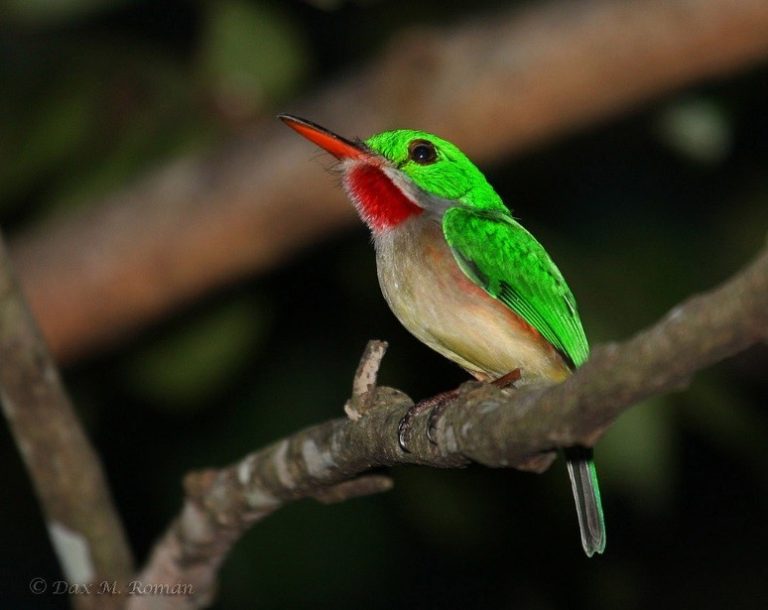Birdfinding.info ⇒ The more common and widespread of Hispaniola’s two todies, Broad-billed can usually be found at sites such as the National Botanical Garden in Santo Domingo, the Rabo de Gato Trail, Los Haitises and Del Este National Parks, and the scrubland beside Lago Enriquillo. It can also be found in the vicinity of the major resorts in the eastern D.R., as at Punta Cana and La Romana.
Broad-billed Tody
Todus subulatus
Endemic to Hispaniola and Gonâve.
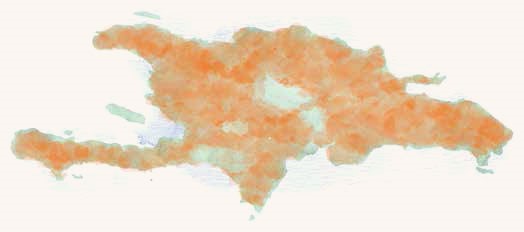
© Alas & Colores
Occurs nearly throughout Hispaniola in lowlands and foothills in both humid and arid zones, including forests, mangroves, open woodlands, thorn scrub, plantations, and large gardens.
Mostly absent from the highlands but it occurs locally up to about 1700 m elevation.
Identification
Brightly colored: glowing-green above, yellowish white below, with a pink blush on the sides, and a largely red bill.
The full extent of the strawberry-pink tufts on its flanks is exposed in flight, but can be covered by folded wings when perched.
The two Hispaniolan todies can often be distinguished at a distance by voice, and sometimes by habitat. Narrow-billed is mostly limited to montane forests, whereas Broad-billed is found in various lowland habitats, but they overlap in some foothill areas. (See below.)
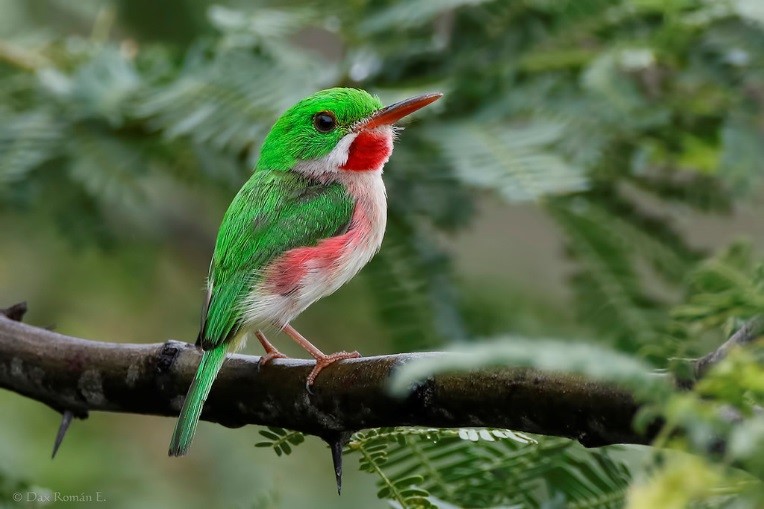
Broad-billed Tody. (Dominican Republic; July 3, 2016.) © Dax M. Román E.

Broad-billed Tody. (Punta Cana Ecological Reserve, Dominican Republic; March 7, 2016.) © Hank Davis
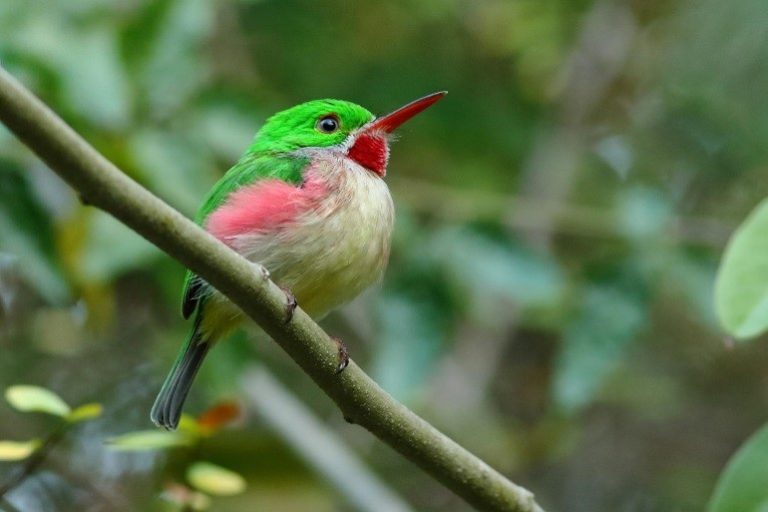
Broad-billed Tody. (Rabo de Gato Trail, Dominican Republic; March 20, 2016.) © Markus Lilje
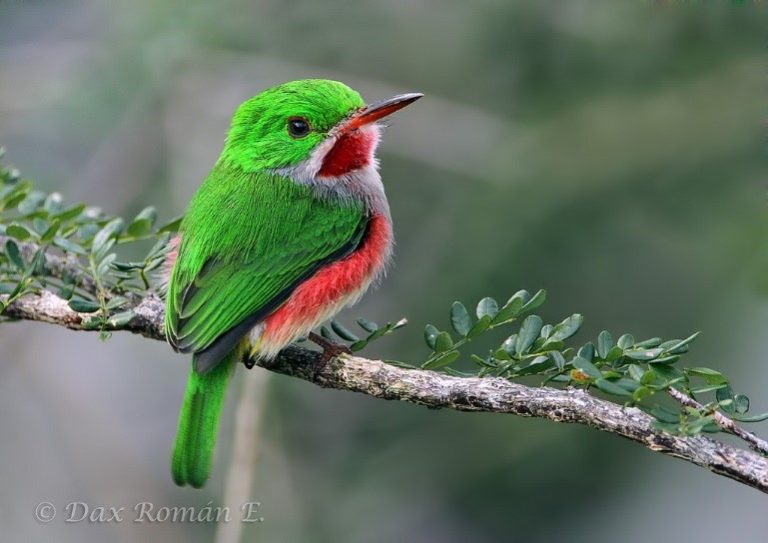
Broad-billed Tody. (Medina, Dominican Republic; January 27, 2013.) © Dax M. Román E.
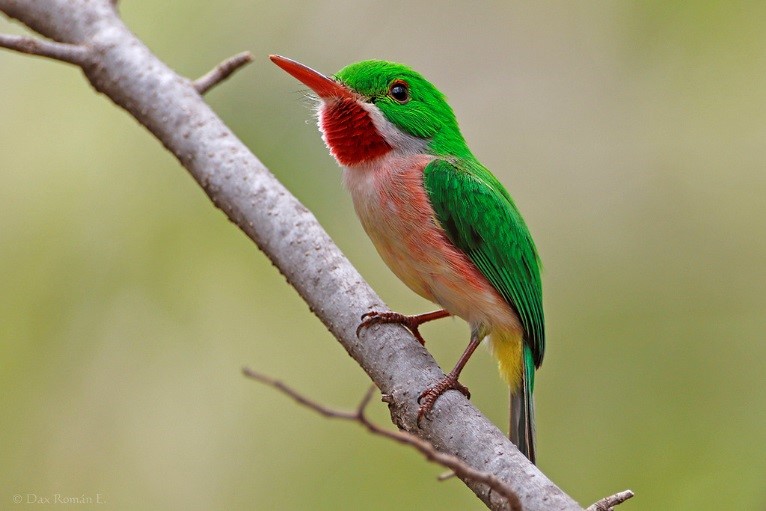
Broad-billed Tody. (Las Mercedes, Dominican Republic; May 30, 2015.) © Dax M. Román E.
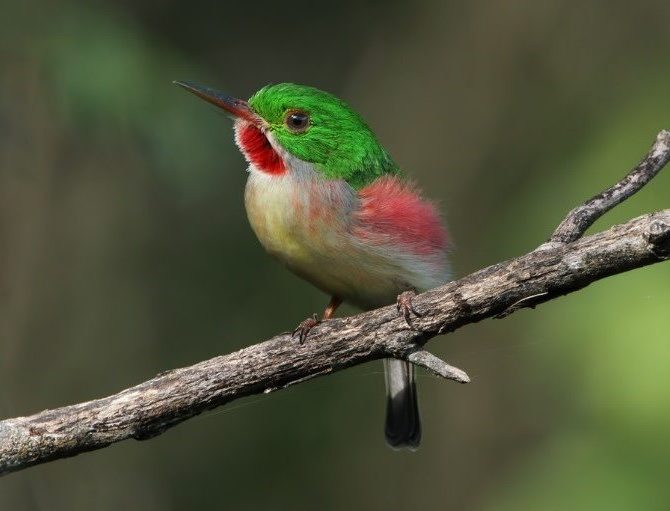
Broad-billed Tody. (Dominican Republic; January 5, 2013.) © Dax M. Román E.
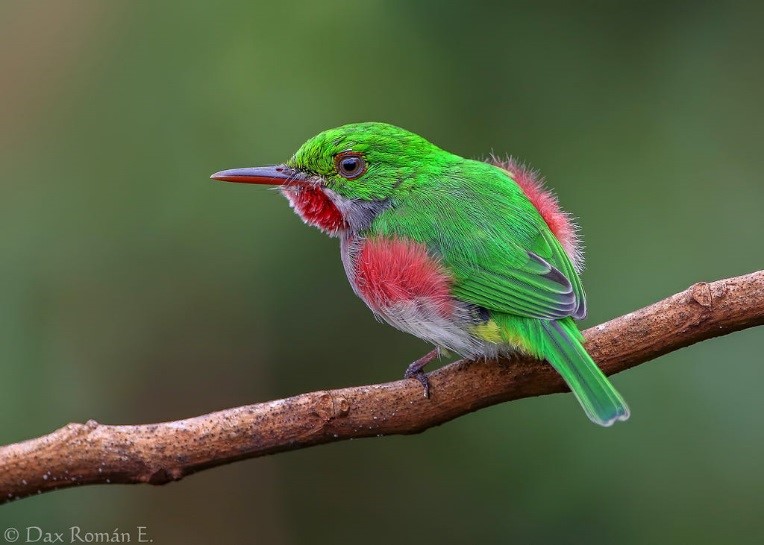
Broad-billed Tody. (Las Mercedes, Dominican Republic; December 27, 2013.) © Dax M. Román E.
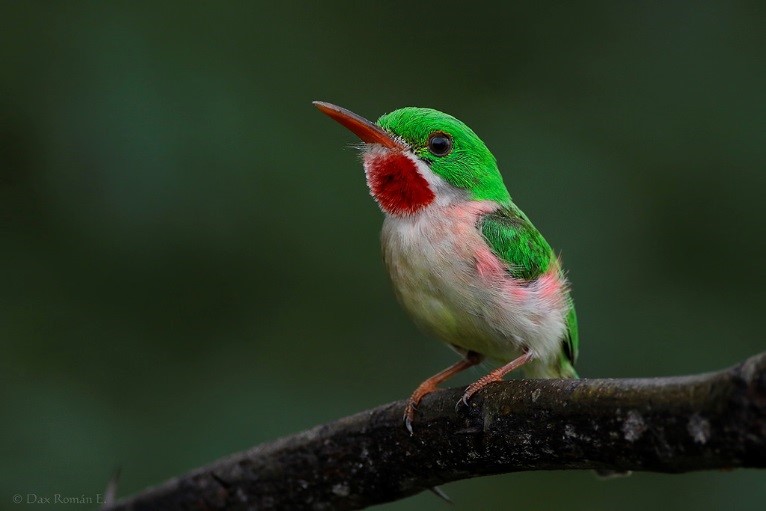
Broad-billed Tody. (Dominican Republic; July 3, 2016.) © Dax M. Román E.
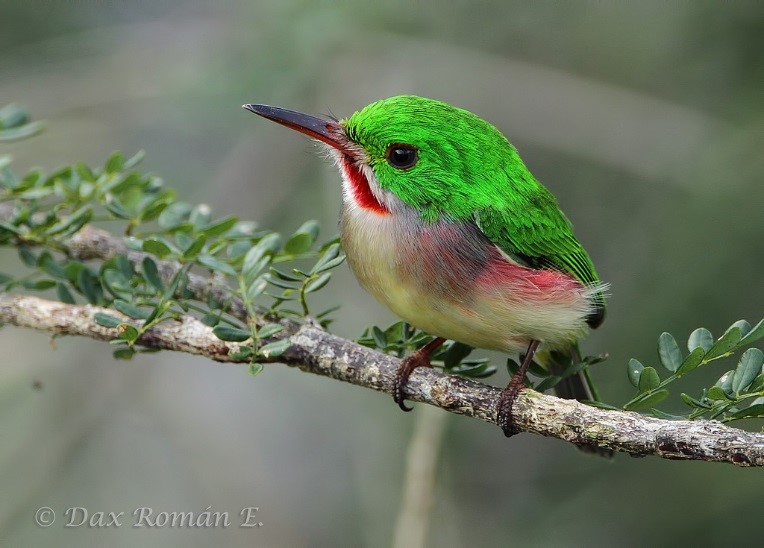
Broad-billed Tody. (Medina, Dominican Republic; January 27, 2013.) © Dax M. Román E.

Broad-billed Tody. (La Placa, Dominican Republic; April 3, 2017.) © Robert Lewis

Broad-billed Tody. (Las Mercedes, Dominican Republic; May 31, 2015.) © Dax M. Román E.
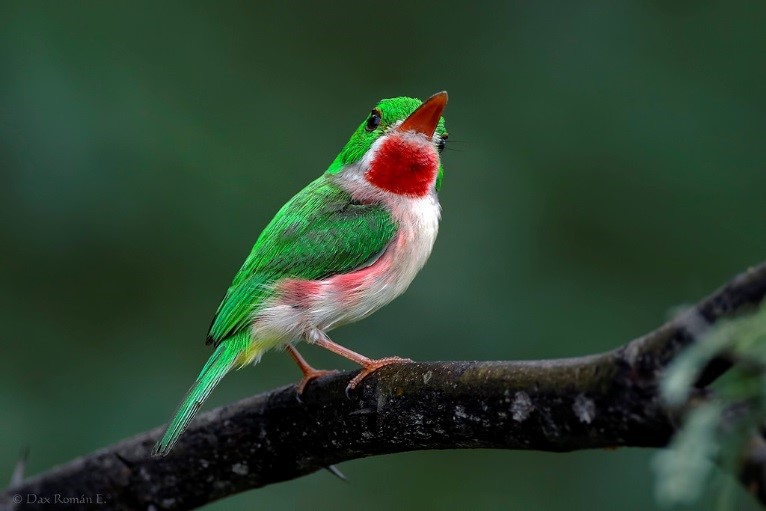
Broad-billed Tody. (Dominican Republic; July 3, 2016.) © Dax M. Román E.
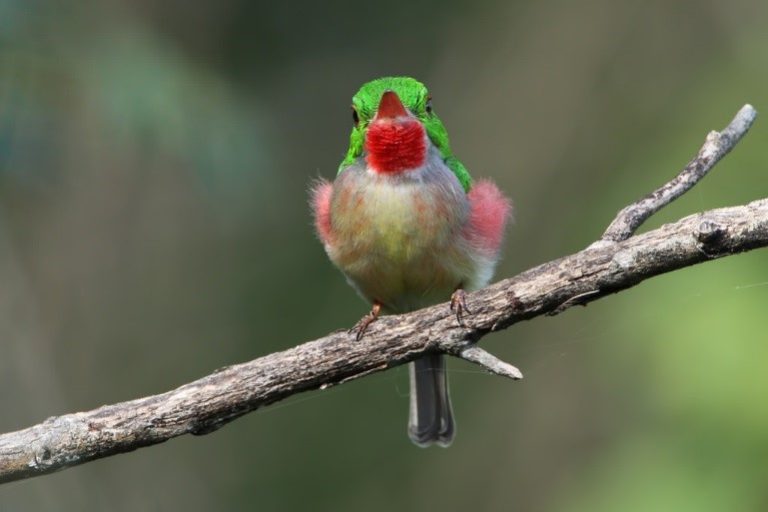
Broad-billed Tody. (Dominican Republic; January 5, 2013.) © Dax M. Román E.
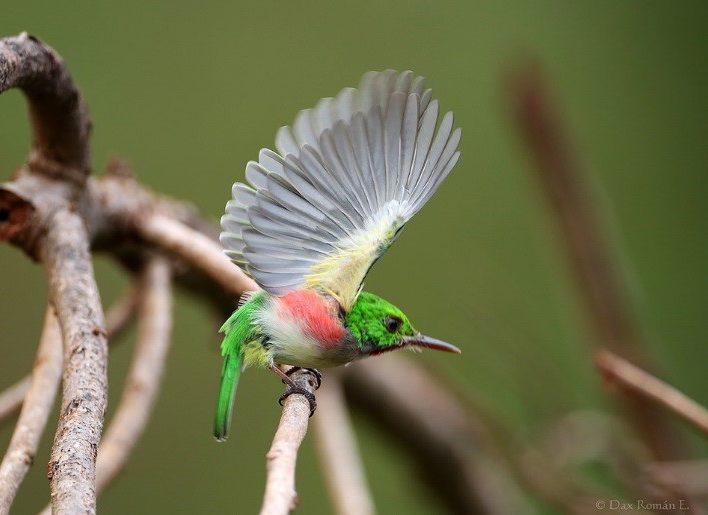
Broad-billed Tody. (Las Mercedes, Dominican Republic; November 1, 2013.) © Dax M. Román E.

Broad-billed Tody. (Rabo de Gato Trail, Dominican Republic; May 11, 2014.) © Paul Noakes
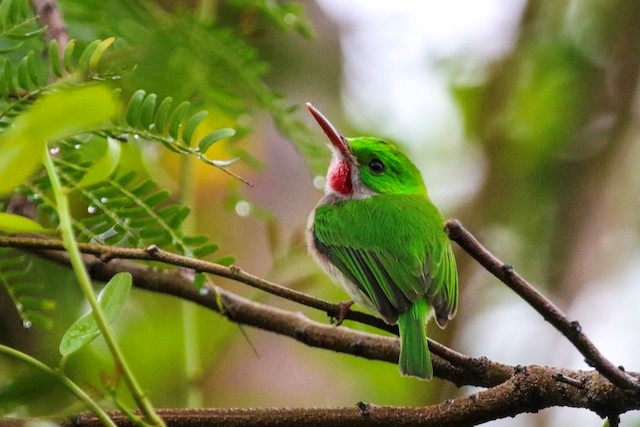
Broad-billed Tody. (Labadie, Haiti; March 16, 2018.) © Graham Williams

Broad-billed Tody. (La Romana, Dominican Republic; March 12, 2015.) © John Sullivan
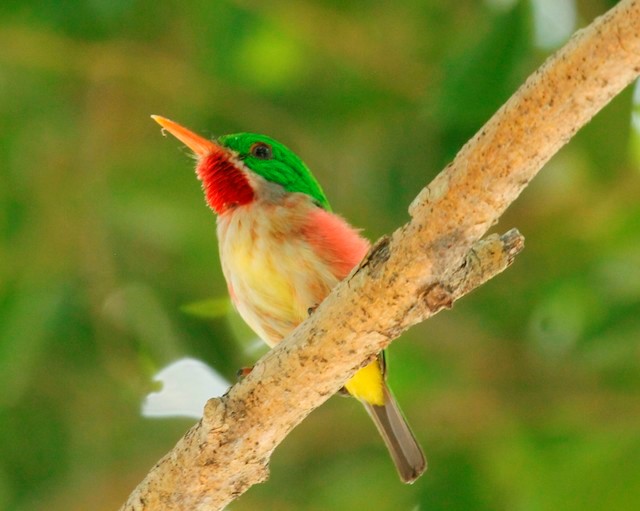
Broad-billed Tody. (Bávaro, Dominican Republic; July 4, 2017.) © Matt Baumann
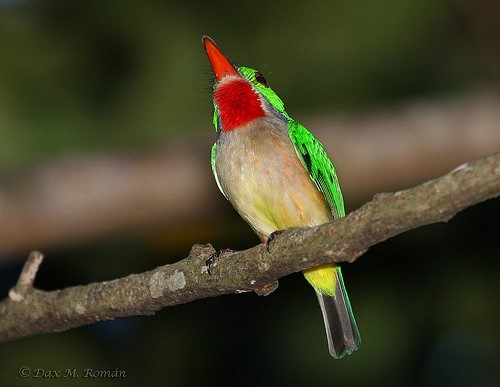
Broad-billed Tody. (Lomas Lindas, Dominican Republic; January 2, 2011.) © Dax M. Román E.
Voice. Common call is a rolling chirp note, repeated over and over:
Cf. Narrow-billed Tody. Broad-billed and Narrow-billed Todies are most readily identified by voice. Habitat is often a strong clue, although there is significant overlap in some areas. Visual identification is possible, but easy to get wrong.
Overall Plumage Tone: The two species share the same overall plumage pattern, but differ in the tone of their coloration. Narrow-billed is “colder”: deep green above and grayish-white below. Broad-billed is more yellowish throughout: i.e., yellowish-green above and yellowish-white below. Both species can show pink sides, but this is usually less extensive and redder on Narrow-billed.
Whisker Mark: Narrow-billed has a prominent, crisply defined white whisker streak that contrasts with the cold gray color of its chest. Broad-billed also has a whisker streak, but it typically contrasts less with the color of its chest.
Bill: Their bill colors are somewhat different. Narrow-billed’s bill is mostly blackish, with a small amount of red toward the base of the lower mandible. Broad-billed’s lower mandible is all red and its upper mandible is partly red, but blackish on the upper surface.
Eyes: Narrow-billed has white irises, whereas Broad-billed’s eyes are usually all-dark.Finally, Narrow-billed has white irises, whereas Broad-billed’s eyes are usually all-dark.
Notes
Monotypic species.
References
Alas & Colores: Broad-billed Tody (Todus subulatus), https://alasycolores.com.do/en/aves/barrancoli.
eBird. 2019. eBird: An online database of bird distribution and abundance. Cornell Lab of Ornithology, Ithaca, N.Y. http://www.ebird.org. (Accessed February 28, 2019.)
Kepler, K.A., and G.M. Kirwan. 2017. Broad-billed Tody (Todus subulatus). In Handbook of the Birds of the World Alive (J. del Hoyo, A. Elliott, J. Sargatal, D.A. Christie, and E. de Juana, eds.). Lynx Edicions, Barcelona. https://www.hbw.com/node/55814. (Accessed November 29, 2017.)
Latta, S., C. Rimmer, A. Keith, J. Wiley, H. Raffaele, K. McFarland, and E. Fernandez. 2006. Birds of the Dominican Republic and Haiti. Princeton University Press, Princeton, N.J.
Overton, L.C. 2011. Broad-billed Tody (Todus subulatus), version 1.0. In Neotropical Birds Online (T.S. Schulenberg, ed.). Cornell Lab of Ornithology, Ithaca, N.Y. https://doi.org/10.2173/nb.brbtod1.01.
Raffaele, H., J. Wiley, O. Garrido, A. Keith, and J. Raffaele. 1998. A Guide to the Birds of the West Indies. Princeton University Press, Princeton, N.J.
